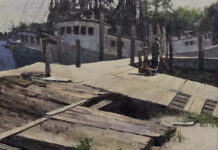
During the Plein Air Convention & Expo (www.pleinairconvention.com), two Chinese-American artists will demonstrate their skillful, painterly approaches to outdoor painting. Here’s a brief review of the high degree of training and varied styles of painting brought to the U.S. by painters who immigrated from China. A complete article will be included in the March 2013 issue of PleinAir.

One of Timothy Tien’s plein air paintings of the Golden Gate Bridge
(Reported by Molly Siple) The hallmark of Chinese artists, above all else, is their technical proficiency. They are expert draftsmen, masters of value and color, and skilled craftspeople thanks to the high quality and demanding standards of art education in China. Their styles have roots in two strains of traditional Chinese brush painting that date back more than 6,000 years, as well as the influence of the European methods of painting that came through the Russian academies.
By the early 20th century, Chinese art schools were teaching European painting methods, with a lineage reaching back to the Paris art academies of the mid-19th century. Such teaching made its way from France to Czarist Russia, which held the French culture in high esteem, and, in turn, Chinese artists traveled to Russia to learn how to paint representationally in the European style, then returned to teach others.

“Protean,” by Zhaoming Wu, oil, 12 x 12 in.
By the 1970s, art students in China were required to have academic training to prepare them for creating realistic works in support of the regime. Mastering pencil drawings of plaster casts, painting for a year or longer in only black and white, and working from the live model were staples of the curriculum. The government established six art academies in various regions of the country, with thousands of hopefuls applying for the few student openings. Many of the Chinese-American artists now living in the United States attended the Guangzhou Academy of Art in Guangdong Province, in the south of China.
These artists also learned from their new American artist friends. As Zhaoming Wu says, “In school we did some landscape painting, usually as preparatory work for a required yearly studio project. But in California, even though my focus has always been the figure, the painters we met pushed us to do more outdoor landscapes, and this led to a great change in how we painted. We began to pay more attention to the drama of lighting in nature, not just classic light on form. And because we were on the West Coast, we started to paint with a lighter and more colorful palette, because of the special atmosphere and intense, bright colors of California.”

A recent plein air painting by Timothy Tien
Timothy Tien is one of a number of award-winning plein air artists. He originates from Hong Kong and first pursued a career in architecture, only later turning to fine art and designing his own course of study with individual artists in Los Angeles. Taking a more contemporary approach, he explains, “I don’t try to copy a scene or photo. I first decide what I want my painting to express, and then I orchestrate the elements within the picture to say what I’m thinking. I don’t want to make pretty pictures. The way I paint is very direct.”
At the next Plein Air Convention & Expo, set for April 10-14, 2013 in Monterey, California (www.pleinairconvention.com), Timothy Tien will join Zhaoming Wu for a live demonstration of their landscape painting techniques.




